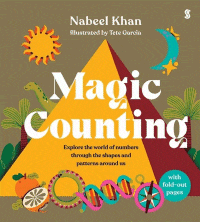
Magic Counting
Magic Counting
Nabeel Khan
Tete Garcia
Scribble Books, 2024
22pp., board book, RRP $A24.99
9781922585400
For generations of kids, maths has been taught as discrete strands of number, space, and measurement with little or no connection between the strands, and more often than not it is taught at a certain time each day making it appear to be a standalone subject with little or no connection to the real world, and generations of kids, particularly girls, have grown up believing that apart from being able to count and perform basic operations, it is a subject that bears little relation to their everyday lives and that it lives in the “too-hard basket”. Whether these attitudes are because of the heavy reliance on textbooks to teach it, or the ease of writing curriculum documents based on those apparently separate areas (although the Australia Curriculum now has algebra, statistics and probability included) , or teachers having the same perceptions as their students, is debatable but the outcome seems to be the same – it is a subject set apart from all others even though it has been called “the queen of sciences”.
Forty years ago when given a class who, at the age of just 8, perceived themselves as already failing at maths because they had been streamed into the bottom group, it was clear to me that there had to be a different approach than the typical traditional textbook they had been following, and so, having had so much success teaching littlies to read with a ‘whole language classroom’ I decided to try a whole-maths classroom, with the outcome being a complete turnaround in attitude and achievement, as well as the publication of many articles in the then-authoritative Classroom magazine, as well as Maths About Me, Maths About My Year and the Eureka Maths program (all for Longman Cheshire.) My basic premise was that maths was everywhere and if we could show students how it connected to and actually drove their lives so they could see its purpose and relevance, they would be more willing to embrace it and invest their time and energy in learning how to understand and use the concepts and processes.
Which is all a long-winded way of explaining why I was so excited to have this new book arrive for review. In it, visual artist Nabeel Khan explores the connections between shapes and numbers and the world in a way that reaches out to both the beginner and the experienced learners. Beginning with the number one – One earth turning, where countless creatures live – the reader then opens the flap=page to discover the circle, its properties and its place in nature and its connections the spiritual beliefs of the world’s peoples, continuing the exploration for each number to ten, Khan builds on his belief that children learn more effectively if we begin from “a place of playfulness, curiosity, and tangible connection to their environment” so that maths is seen as a connected whole from the get-go. “We can find numbers and shapes everywhere: in the natural world, in art and architecture, in symbolism, and in the sky above us.”
Back in those delightful days when we were allowed to use our imaginations to teach, one of the favourite activities was to explore a maths trail where students would investigate the shapes, numbers, measurements and all the other things in the environment, whether that was around the school, around the shopping centre or even a national institution like the Australian War Memorial. Sometimes they followed trails that others had set, but often they made up their own; sometimes that had to find the correct term for a pattern of bricks and sometimes they just had to add the numbers on their letterbox but either way it provided authentic fun learning across all aspects of the discipline and all ages of the student body. Maybe this book will inspire a similar way to discover the magic as they look more closely at the maths in the world around them.
Needless to say, this is a book that has captured my interest and one that I believe, should not only be in the library’s collection but in each teacher’s toolbox because it has the potential to have a profound impact on the way we teach and understand this vital topic.